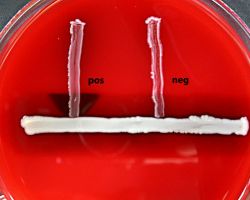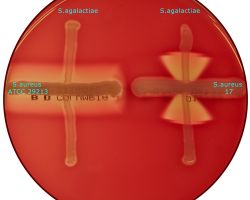SEARCH
Search
CAMP-test_Streptococcus agalactiae
-
General
Streptococcus agalactiae is CAMP-test positive.
The test is carried out by streaking a beta-hemolysis producing Staphylococcus aureus (ATCC 25923) strain and Streptococcus agalactiae parallel to each other on a blood agar plate.
Suspect cultures are streaked at right angles in between (but not touching) the two streakes.
Hemolysis by Streptococcus agalactiae is enhanced in the vicinity of S. aureus.
-
History
The CAMP factor reaction was first described in 1944 by Christie, Atkins and Munch-Peterson and reverse to the synergistic lysis of erythrocytes by the beta hemolysin of Staphylococcus aureus and the extra cellular CFB protein of Streptococcus agalactiae.
-
Related
-
References
Manual of Clinical Microbiology
10th edetion
James Versalovic et all
Foto's
MMIZ
erasmusMC Rotterdam


